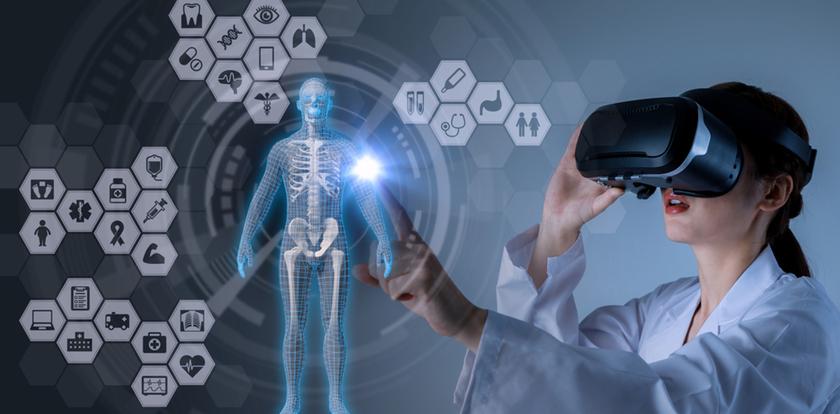
3D in medicine: virtual world and new technologies
Until now, we have associated virtual reality with computer games, a dream world created for entertainment. Has anyone thought that something that is a source of pleasure could become one of the diagnostic tools in medicine in the future? Will the actions of doctors in the virtual world make better specialists? Would they be able to engage in human interaction with a patient if they learned it by talking only to a hologram?
Progress has its own laws - we are mastering new areas of science, creating new technologies. It often happens that we create something that originally had a different purpose, but find a new use for it and extend the original idea to other areas of science.
This is what happened with computer games. At the beginning of their existence, they were supposed to be only a source of entertainment. Later, seeing how easily this technology found its way to young people, educational games were created that combined entertainment with learning to make it more interesting. Thanks to progress, their creators tried to make the created worlds as real as possible, achieving new technological possibilities. The result of these activities are games in which the image quality does not distinguish fiction from reality, and the virtual world becomes so close to the real that it seems to bring our fantasies and dreams to life. It was this technology that a few years ago fell into the hands of scientists who were trying to modernize the process of training doctors of a new generation.
Train and plan
All over the world, medical schools and universities are faced with a serious barrier in teaching medicine and related sciences to students - the lack of biological material for study. While it is easy to produce cells or tissues in laboratories for research purposes, this is becoming more of a problem. receiving bodies for research. Nowadays, people are less likely to save their bodies for research purposes. There are many cultural and religious reasons for this. So what should students learn? Figures and lectures will never replace direct contact with the exhibit. Trying to cope with this problem, a virtual world was created that allows you to discover the secrets of the human body.
Virtual image of the heart and thoracic vessels.
Tue 2014, prof. Mark Griswold from Case Western Reserve University in the USA, took part in the study of a holographic presentation system that takes the user into a virtual world and allows him to interact with it. As part of the tests, he could see the world of holograms in the surrounding reality and establish contact in the virtual world with another person - a computer projection of a person in a separate room. Both parties could talk to each other in virtual reality without seeing each other. The result of further cooperation between the university and its staff with scientists was the first prototype applications for the study of human anatomy.
Creating a virtual world allows you to recreate any structure of the human body and place it in a digital model. In the future, it will be possible to create maps of the whole organism and explore the human body in the form of a hologram, watching him from all sides, exploring the secrets of the functioning of individual organs, having before his eyes a detailed picture of them. Students will be able to study anatomy and physiology without contact with a living person or his dead body. Moreover, even a teacher will be able to conduct classes in the form of his holographic projection, not being in a given place. Temporal and spatial restrictions in science and access to knowledge will disappear, only access to technology will remain a possible barrier. The virtual model will allow surgeons to learn without having to perform operations on a living organism, and the accuracy of the display will create such a copy of reality that it will be possible to faithfully reproduce the realities of a real procedure. including the reactions of the entire body of the patient. Virtual operating room, digital patient? This has not yet become a pedagogical achievement!
The same technology will allow the planning of specific surgical procedures for specific people. By carefully scanning their bodies and creating a holographic model, doctors will be able to learn about their patient's anatomy and disease without performing invasive tests. The next stages of treatment will be planned on models of diseased organs. When starting a real operation, they will perfectly know the body of the operated person and nothing will surprise them.
Training on a virtual model of the patient's body.
Technology will not replace contact
However, the question arises, can everything be replaced by technology? No available method will replace contact with a real patient and with his body. It is impossible to digitally display the sensitivity of tissues, their structure and consistency, and even more so human reactions. Is it possible to digitally reproduce human pain and fear? Despite advances in technology, young doctors will still have to meet real people.
Not without reason, several years ago, it was recommended that medical students in Poland and around the world attend sessions with real patients and form their relationships with people, and that academic staff, in addition to acquiring knowledge, also learn empathy, compassion and respect for people. It often happens that the first real meeting of medical students with a patient occurs during an internship or internship. Torn from academic reality, they are unable to talk to patients and cope with their difficult emotions. It is unlikely that the further separation of students from patients caused by new technology will have a positive impact on young doctors. Will we help them to simply remain human beings by creating excellent professionals? After all, a doctor is not an artisan, and the fate of a sick person largely depends on the quality of human contact, on the trust that the patient has in his doctor.
Long ago, the pioneers of medicine—sometimes even in violation of ethics—acquired knowledge solely on the basis of contact with the body. The current medical knowledge is actually the result of these quests and human curiosity. How much more difficult it was to cognize reality, still not really knowing anything, to make discoveries, relying solely on one's own experience! Many surgical treatments were developed through trial and error, and although sometimes this ended tragically for the patient, there was no other way out.
At the same time, this sense of experimentation on the body and the living person in some way taught respect for both. This made me think about every planned step and make difficult decisions. Can a virtual body and a virtual patient teach the same thing? Will contact with a hologram teach new generations of doctors respect and compassion, and will talking with a virtual projection help develop empathy? This issue is faced by scientists implementing digital technologies in medical universities.
Undoubtedly, the contribution of new technical solutions to the education of doctors cannot be overestimated, but not everything can be replaced by a computer. Digital reality will allow specialists to receive an ideal education, and will also allow them to remain “human” doctors.
Visualization of the technology of the future - a model of the human body.
Print models and details
In world medicine, there are already many imaging technologies that were considered cosmic a few years ago. What we have at hand 3D renderings is another extremely useful tool used in the treatment of difficult cases. Although 3D printers are relatively new, they have been used in medicine for several years. In Poland, they are mainly used in treatment planning, incl. heart surgery. Every heart defect is a big unknown, because no two cases are the same, and sometimes it is difficult for doctors to predict what might surprise them after opening a patient's chest. The technologies available to us, such as magnetic resonance imaging or computed tomography, cannot accurately show all structures. Therefore, there is a need for a deeper understanding of the body of a particular patient, and doctors provide this opportunity with the help of XNUMXD images on a computer screen, further translated into spatial models made of silicone or plastic.
Polish cardiac surgery centers have been using the method of scanning and mapping heart structures in 3D models for several years, on the basis of which operations are planned.. It often happens that only the spatial model reveals a problem that would surprise the surgeon during the procedure. The available technology allows us to avoid such surprises. Therefore, this type of examination is gaining more and more supporters, and in the future, clinics use 3D models in diagnosis. Specialists in other fields of medicine use this technology in a similar way and are constantly developing it.
Some centers in Poland and abroad are already carrying out pioneering operations using bone or vascular endoprostheses printed with 3D technology. Orthopedic centers around the world are 3D printing prosthetic limbs that are ideally suited to a particular patient. And, importantly, they are much cheaper than traditional ones. Some time ago, I watched with emotion an excerpt from a report that showed the story of a boy with an amputated arm. He received a XNUMXD-printed prosthesis that was a perfect replica of the arm of Iron Man, the little patient's favorite superhero. It was lighter, cheaper and, most importantly, perfectly fitted than conventional prostheses.
The dream of medicine is to make every missing body part that can be replaced with an artificial equivalent in 3D technology, adjustment of the created model to the requirements of a particular patient. Such personalized "spare parts" printed at an affordable price would revolutionize modern medicine.
Research into the hologram system continues in collaboration with physicians from many specialties. They already appear first apps with human anatomy and the first doctors will learn about the holographic technology of the future. 3D models have become part of modern medicine and allow you to develop the best treatments in the privacy of your office. In the future, virtual technologies will solve many other problems that medicine is trying to fight. It will prepare new generations of doctors, and there will be no limit to the spread of science and knowledge.

